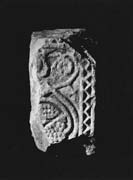Select a site alphabetically from the choices shown in the box below. Alternatively, browse sculptural examples using the Forward/Back buttons.
Chapters for this volume, along with copies of original in-text images, are available here.
Object type: Shaft fragment [1] [2]
Measurements: H. 37.5 cm (14.8 in) W. 23 > 17 cm (9 > 6.7 in) D. 20 cm (7.9 in)
Stone type: Fine-grained feldspathic, micaceous sandstone; poorly sorted. Very pale brown (10YR 7/3). Probably from the Upper Carboniferous (Westphalian, Coal Measures); source unknown
Plate numbers in printed volume: Ills. 662–4
Corpus volume reference: Vol 6 p. 180-181
(There may be more views or larger images available for this item. Click on the thumbnail image to view.)
A (broad) : The left-hand side is lost. On the right between two well-modelled mouldings is a run of vertical zig-zag, remains of which survive as a transverse moulding at the top. Within the panel is part of a medallion plant-scroll. The upper terminating half-medallion has a pair of nodding leaf flowers or seed pods with narrow triangular leaves on stems serving as sepals. Within the lower medallion are two long triangular berry bunches arranged on a diagonal axis. Within the spandrel is a triple leaf spray, veined.
B (narrow) : The edge moulding is well modelled and contains an inner more slender moulding; both are in high relief. Within the panel is a tree-scroll with vertical axial stem. Three pairs of scrolls survive, each with a rosette berry bunch at its centre and surmounted by a frondy split leaf attached to the main stem.
C (broad) : Damaged. The double modelled edge moulding survives in part at the left. The panel contains a spiral plant-scroll, probably in a double fleshy strand. The top is lost but Collingwood's drawing (fig. f) shows a rosette berry bunch in the topmost scroll. The right-hand side is lost.
D (narrow) : Broken away.
In 1907 the piece was 'in a very fragile condition, coming off in flakes when handled' (Collingwood 1907, 372); hence the drawing is important evidence of lost features. The zig-zag border associates it with the cross-head, no. 5 (Ills. 672–6), as Collingwood'suggested, and the two share the double-stranded spiral scroll motif, but there is a difference in thickness of some 7.5 cm. Tree-scrolls are uncommon in the region: one on Croft 1 is inhabited and less foliate (Ill. 152). The medallion scroll with long triangular berry bunches is similar to Acca's cross at Hexham, Northumberland (Cramp 1984, 174–6, pls. 167–171), though here the stems are not interlaced. The only north Yorkshire parallel is the spare version on Gilling East 1 in Ryedale (Lang 1991, 133, ill. 440). Clearly, as with no. 5 (see pp. 182–3), the relationships are not local but with monastic foundations across Northumbria which employed a common ornamental repertoire. Coupled with the cross-head, there is an undoubted link with Bernician centres, be they at Hexham or Jarrow. The Ripon and Hexham analogues do suggest continuing links between the two Wilfridian foundations well into the eighth century (Chap. VI, pp. 40–1).
[1] The following are general references to the Northallerton stones: Browne 1880–4, cx, cxi; Allen and Browne 1885, 352; Saywell 1885, 5, 6, 218, 219, 222; Saywell 1886, 480–1; Bulmer 1890, 525, 526; Robinson, J. 1890, 35, fig. 9; Hodges 1894, 195; Morris, J. 1904, 280, 420; Bogg 1908, 14; Collingwood 1912, 110, pl. III; Page, W. 1914, 426, 429; Morris, J. 1931, 280, 417; Elgee and Elgee 1933, 195, 249; Mee 1941, 169; Pevsner 1966, 271; Bailey 1980, 240, 252, 255; Cambridge 1989, 382, 384, 385; Morris, R. 1989, 138; Hadley 2000, 244; Stocker 2000, 205–6. The following is an unpublished manuscript reference to the Northallerton stones: BL Add. MS 37552 no. XIV, item 702 (Romilly Allen collection).
[2] The following is an unpublished manuscript reference to no. 1: BL Add. MS 37552 no. XIV, item 705 (Romilly Allen collection).



